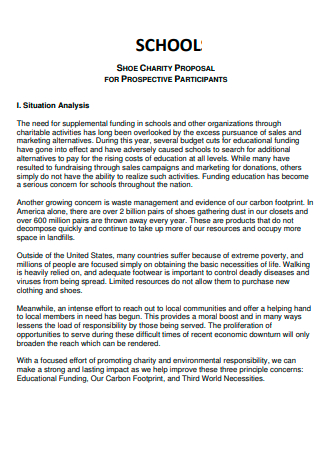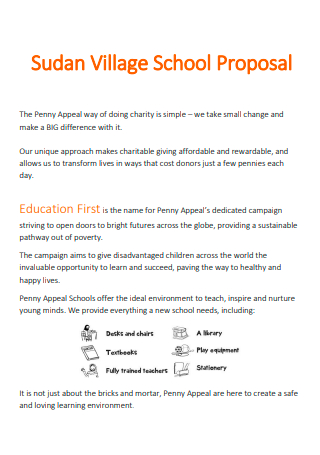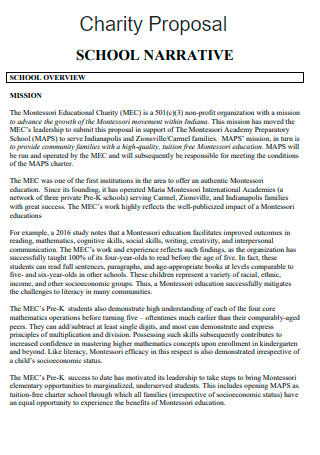8+ Sample School Charity Proposal
-

School Charity Proposal Form
download now -

Printable School Charity Proposal
download now -

School Event Charity Proposal
download now -

School Charity Proposal in PDF
download now -

Secondary School Registered Charity Proposal
download now -

Village School Charity Proposal
download now -

School Charity Organization Proposal
download now -

School Narrative Charity Proposal
download now -

School Charity Proposal Example
download now
FREE School Charity Proposal s to Download
8+ Sample School Charity Proposal
a School Charity Proposal?
Benefits of Donating in Charity
Types of Charitable Giving
How To Create a School Charity Proposal
FAQs
What services do educational charities provide?
Is a maintained school a charitable organization?
Why do schools participate in charitable activities?
What Is a School Charity Proposal?
A charity school is a learning institution funded by charitable donations and is sometimes operated by religious organizations. A school charity proposal, a written document that tries to raise cash for the school, seeks finances or donations for an important cause or purpose. And the nature and goal of school money-raising can differ. A school charity proposal is typically prepared and written by a fundraising organization to cultivate an idea and concept for building new schools in a caring endeavor to help abandoned, orphaned, or less fortunate children receive an education comparable to other children in society. According to research, you are legally permitted to deduct charitable contributions up to 60% of your adjusted gross income, but again, if you exceed that 3% rate, the IRS will almost certainly audit your return.
Benefits of Donating in Charity
Some things in life are better for your health than others. Walking and movement keep your mind and body in good shape. Fruits and vegetables give your insides the boost they need to keep running efficiently. Talking about your feelings allows you to be gentler with yourself. Giving to charity can assist you in achieving happiness in your own life. The list goes on and on! Today, we’re going to concentrate on the health benefits of donating to charity. When you donate, you’ll find health in various ways, from enhanced enjoyment to improved self-worth. Find out more in the sections below!
Types of Charitable Giving
A charitable donation is one method to demonstrate your commitment to a cause or organization near and dear to your heart. Financially, charity giving can also play a significant role in your inheritance, tax, and financial planning. Depending on the nature of your estate, the amount of money you wish to give, and how you want to gift, you may be unsure of the form of charitable giving that is most appropriate for you and your philanthropic objectives.
-
1. Donor-Advised Funds
A donor-advised fund is a kind of philanthropic giving in which you make a non-refundable donation to a nonprofit association of your choice, either in cash or stocks. In 2020, charitable grants from donor-advised funds will exceed $34 billion. One advantage of this process of giving is that you can advise the fund administrator to make gifts to the causes or organizations with which you are most identified. Also, you obtain the maximum tax benefit from the IRS for your assistance immediately, and you can establish funds that will continue to operate even after your death.
2. Cash
A monetary contribution is the simplest form of charity giving. Your tax deduction equals the monetary donation less the value of any goods or services received in exchange. For instance, memberships in charitable organizations such as a zoo or another institution are considered cash donations. No titles, certificates, or stocks are transferred with a monetary donation. The perk of gifting cash is relatively straightforward to execute, and there are no complicated tax deductions or benefits to handle. All you’ll need is a record of the cash contribution. According to the IRS, you cannot deduct cash contributions, regardless of their size, unless you have a history or receipt for them.
3. Stocks
Contributing long-term valued protection, such as stocks, is one of the most tax-efficient methods to gift. There are two advantages to making this type of donation. First, because you are not selling your stocks, you are not subject to capital gains taxes. The second advantage is that you can donate any supplies purchased more than a year ago with a current value more significant than their initial cost and qualify for a tax deduction equal to the stock’s total fair market value.
4. Assets
Sharing your assets to charity, such as retirement funds and life insurance policies, has some advantages, including the fact that your estate will not have to recognize the gifted income, potentially saving you money on the estate tax. Many people also choose to use assets that would otherwise be subject to income tax, leaving tax-deferred accounts in their estate for beneficiaries, giving them a tax-free inheritance. You might have substantial assets that you’d like to contribute to a good cause. Art and jewelry, for example, may qualify you for a tax deduction equal to the value of the things you’ve donated. If your item is directly tied to the charity’s goal or objective, such as art to a museum, you’re more likely to earn an immense tax credit than if you give something that isn’t.
5. Income Fund
A shared income fund may be the ideal option to produce income while also giving smaller sections to charity. To make a more significant sum of money to donate to charity, you can “pool” several securities and combine them with cash. Money is distributed to you and any other beneficiaries who have contributed to the fund with assets pooled together. The rest of the pooled income fund is donated to charity after your death. You may be eligible for a charitable tax deduction equal to the amount of money a charity expects to receive in some situations.
6. Private Foundations
Private foundations are charity trusts or corporations that have been established as charitable trusts or corporations. If you want to start your charitable foundation, a private foundation is a terrific way to enlist the help of your family, especially if you have a cause close to your heart. Although more stringent restrictions and tax requirements exist, a private foundation can donate to individuals and control contributed assets.
How To Create a School Charity Proposal
Along with serving as a roadmap for starting and administering the project, a project proposal must also market the idea to the charity’s leadership and convince donors to contribute financially to the effort. Presentation is just as critical as a substance to people who will read your proposal. Create a comprehensive proposal that you can submit in its whole or sections via forms, cover letters, or inquiry letters. The completed project should be exhaustive, engaging, and error-free.
-
1. Executive Summary
The executive summary, or abstract, summarizes the information contained in the project proposal. Although the executive summary is the first portion of the proposal, you may write it or complete it after the bid is complete. Please have a brief description of your organization, the project, and the need it solves in the executive summary. Include information regarding the design, scope, and evaluation of the project. If the proposal is for funds, include a budget summary and the amount requested from the funder. Your executive summary should be simple to skim for responses that pique the reader’s interest in the complete proposal. A poorly written executive summary may cause the reader to disregard your proposal.
2. Define the Situation
Conduct research into the demand addressed by your project. For instance, utilize state and federal resources to identify poverty and transportation problems in your city. Describe the target population, for example, low-literacy families. Discuss available resources, if any, and why the demand continues to be unmet. For instance, two teen pregnancy programs serve a small percentage of the target population or give parenting education but not housing. Your plan should reflect your familiarity with the subject and local resources.
3. Project Design
Before attempting to define your idea in a proposal, you should fully develop all components of it. Justify your project’s objectives, such as improving reading grade levels. Describe your project’s operations in full, including the fiscal year, location, marketing, staffing, and collaborative partnerships with other organizations. Include information regarding the number of people who will benefit from your initiative, as well as your record-keeping procedures. Funders, in particular, are interested in learning about evaluation methodologies. For instance, you may demonstrate client happiness by conducting surveys or tracking the work status of participants.
4. Budget and Funding Estimates
The project budget reveals to readers that you have taken the time to correctly estimate project costs and conduct research on prospective funding sources. Include all anticipated expenses for the project year, including wages, supplies, equipment, construction costs, and administrative or overhead costs. Prepare a separate table listing all donors to whom you intend to submit the proposal and the percentage of the budget requested from each. Create a list-style budget narrative that details each line item in the budget.
5. Development of Resources
Demonstrate your attempts to discover resources for your project, either in the proposal narrative or the budget—donated space for financial literacy workshops, for example, or donated computers and office equipment. Demonstrate how utilizing volunteers rather than paid staff saves money and engages the community. Funders want to know how you intend to support your project through fundraising events, such as a direct mail campaign to previous donors or by budget allocation of your organization’s finances.
FAQs
What services do educational charities provide?
Education charities in emerging nations often work to enhance children’s time in school and the quality of instruction they get through building schools, tutoring outside of the classroom, boosting literacy, rewarding attendance, and providing materials and technology.
Is a maintained school a charitable organization?
Maintaining schools and academy trusts, as exempt charities, must and can do more than proclaim their exempt charity status. Their status as exempt charities necessitates compliance with applicable charity laws.
Why do schools participate in charitable activities?
Charity fosters the development of empathy, a vital social and emotional trait. One may argue that philanthropic activities are critical for developing a sense of citizenship – both individual engagement and participation in collective school activities – and fostering a broader understanding of social responsibility.
There are almost certainly numerous positive advantages to promoting charities in schools. One may argue that philanthropic activities are critical for developing a sense of citizenship – both individual engagement and participation in collective school activities – and fostering a broader understanding of social responsibility. Hoping this article has expanded your knowledge about the importance of supporting schools and how it can benefit you.
